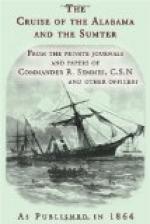At last, however, as the impatient crew of the Alabama were beginning to think that their enemy’s flag had finally vanished from the face of the ocean, an adventurous barque hove in sight, with the old familiar bunting at her peak. She proved to be the Conrad, of Philadelphia, from Buenos Ayres for New York, partly laden with wool, the ownership of which was, as usual, claimed as neutral. On investigation, the claim proved an evident-fabrication, the facts of the case being as follows:—
CASE OF THE CONRAD.
Ship under American colours and register. A Mr. Thomas Armstrong, who describes himself as a British subject doing business at Buenos Ayres, makes oath before the British Consul that a part of this wool belongs to him and a part to Don Frederico Elortando, a subject of the Argentine Republic. This may or may not be true, but the master is unable to verify the document, he not having been present when it was prepared, and not knowing any thing about it. There is, besides, so strong a current of American trade with Buenos Ayres, that the presumption is, from the very fact that this wool was going to New York in an American barque, under the imminency of capture, which our presence in these seas—well known at Buenos Ayres when the barque sailed—must have shown, that the property is American, and that the certificate is an attempt to cover it; Mr. Armstrong probably being a brother or a partner in the transaction with some American house. Ship and cargo condemned.
* * * * *
FURTHER EXAMINATION OF CASE OF CONRAD.
From an examination of the correspondence in this case, brought on board after the ship’s papers had been examined, it appeared that Mr. Armstrong, the party shipping a part of the cargo, swears before his consul that he and one Don Frederico Elortando, are the owners of the property, and swears before the United States Consul that he is the sole owner of the property. Both of these oaths cannot be true. It further appears that, whilst the property in the bill of lading is consigned to Simon de Visser, Esq., in the letters of Messrs. Kirkland and Von Sachs it is spoken of as consigned to them. The letters make no mention of any joint-ownership with Armstrong, but treat the consignment as his sole property. But though, like so many of her countrymen, condemned, the Conrad was not to die. A nobler fate was in store for her—no less a destiny than that of carrying the proud young flag to which she had succumbed, and taking the sea, under a new name, as the consort of her captor. Accordingly, Acting-Lieutenant Low was appointed to the command, assisted by Acting-Master Sinclair and two master’s mates. The two rifled pounders captured in the Talisman were mounted on board, a due complement of rifles, revolvers, ammunition, &c., supplied, and then the transformed barque fired her first gun, ran up the Confederate ensign to her peak, and amid a burst of cheering from her own crew and that of her consort, made a fresh start in life as the Confederate States sloop-of-war Tuscaloosa.




